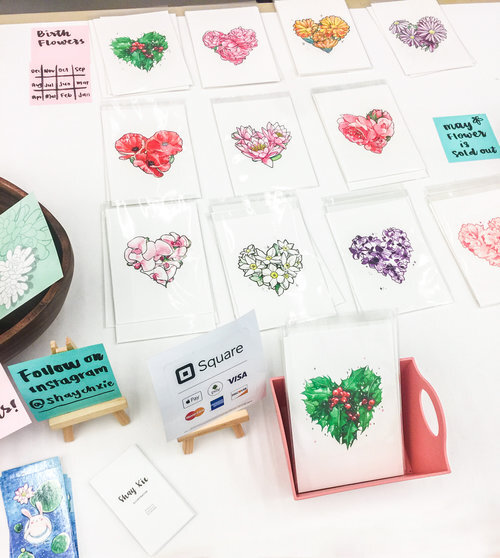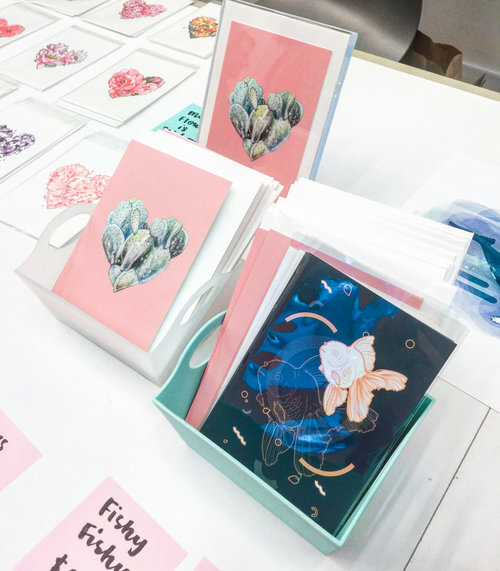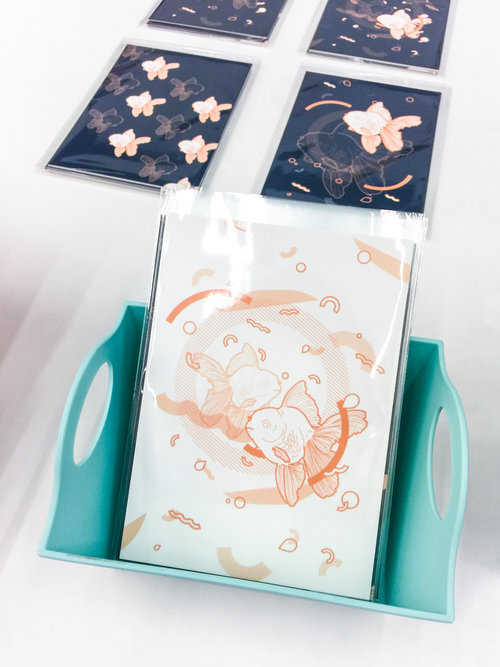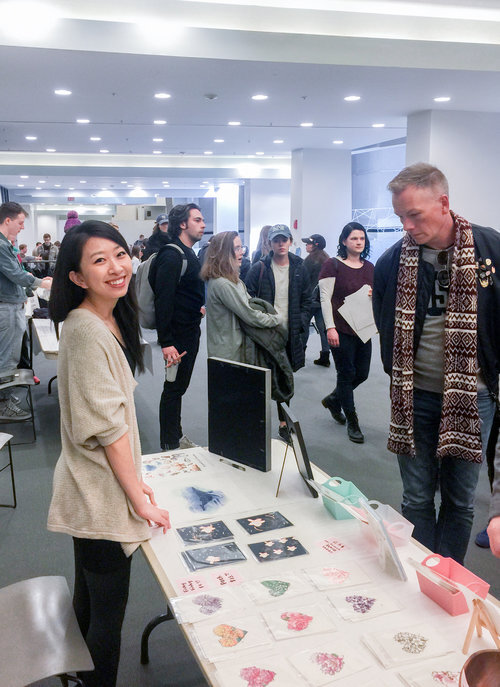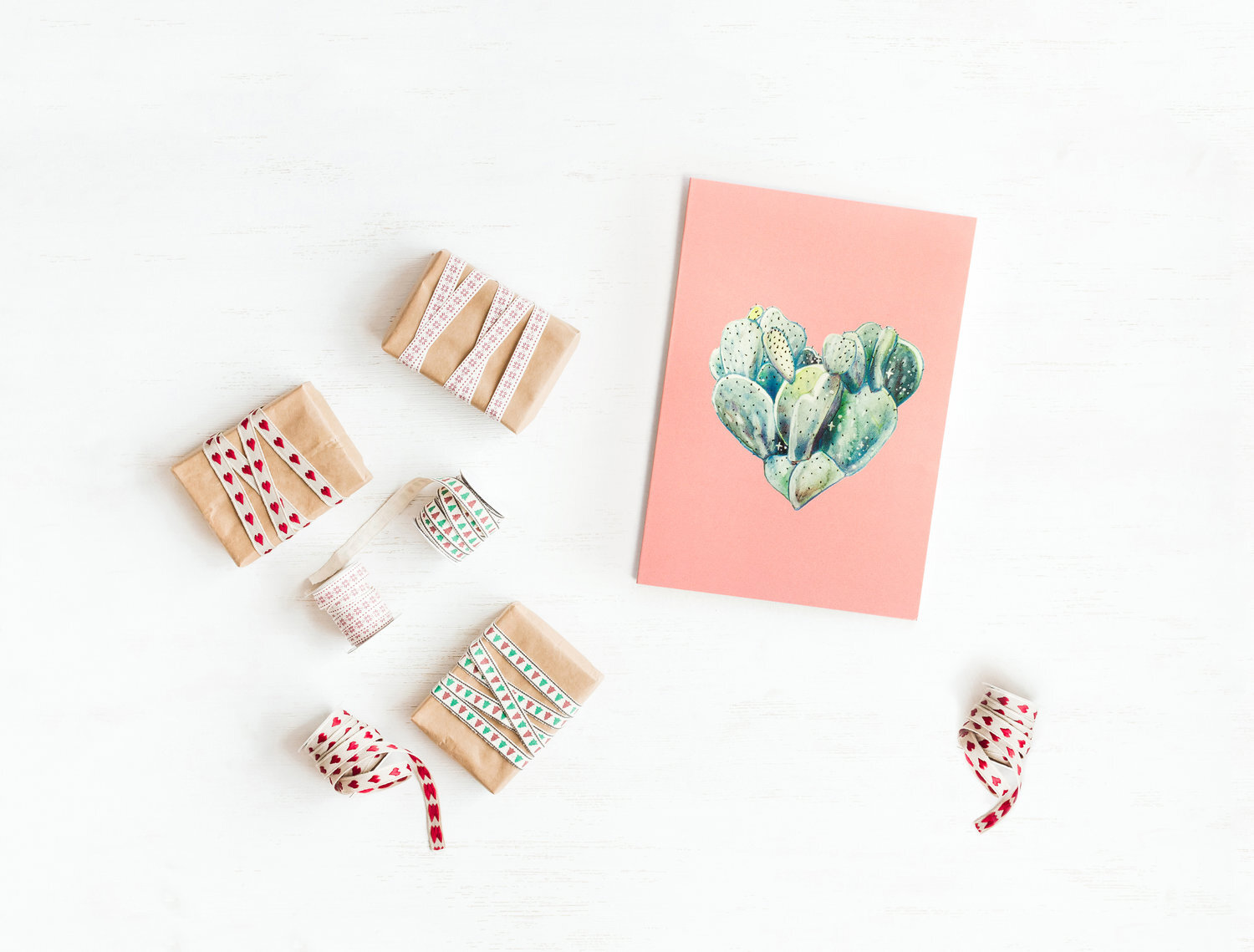First Gig At DAAP Makers + Reflections
Sometimes I feel that I have so much fun work that I have a burning desire to liberate them from behind the 2D screens. I become so excited and anxious to see how they would look in print that they are the only things on my mind. But once I get started on school assignments – which is my nightly ritual – my plans get pushed aside and my zealousness put on hold... I want to make them come true someday, but someday just isn't enough – when you tell yourself that one day you will do the thing you want to do, how soon does it happen without a deadline?
I needed a push. And DAAP Makers Market came right along.
Above: DAAP Makers Market is the first marketplace organized by DAAP student groups that bring students, alumni, and professors together to showcase their work (mostly side projects). It also connects these local makers with the larger Cincinnati community who love and appreciate original design and art pieces and facilitates face-to-face interactions between them.
Below: My booth at DAAP Makers Market
I had a blast meeting new people and talking about my work. The sales exceeded my expectation, and I was super thrilled! From this great experience, I see a few opportunities for improvement. Here are five lessons I have learned and would like to share with anyone looking for suggestions for their first gig selling stuff.
1. Plan Ahead
I'm always a huge planner but why do I still emphasize this? Because I ordered some stuff super early and yet I waited until the last minute for other things. For example, I thought I might make more stickers to sell at the show, so I held off on ordering my stickers to save shipping cost. But in the end, I ended up not doing more stickers and only ordered the one roll from the beginning. But by the time I put in my order, the turnaround and shipping time was too late for DAAP Makers, so I had to rush it, which resulted in more $$$. I also ended up having multiple shipping orders from the same vendor and could have saved up that shipping cost had I knew what I needed before ordering.
When planning, you want to keep a list and check things off as you go – now that I am thinking about it, it might be helpful to add the dates you have to have everything ordered to avoid rushing your orders.
Also, sometimes the dimensions of the products you order don't fit perfectly together...you want to allow yourself some time to recover from these little setbacks as well and reorder things as quickly as possible.
Note: Not everything got done. Some things were left unchecked on my list because I changed my mind or because I didn't have time.
2. Research, Research, Research
Again, planning is HUGE, but you have to research to figure out what you need to plan for.
I follow some stationery designers on Instagram and have done some research on the National Stationery Show for my app design project, so at least I knew what to expect – protective plastic sleeves for greeting cards and postcards, product display, as well as payment options. I adore the photo journals by Oh My Beautiful Paper from her visit to the National Stationery Show and wish I had the time and budget to do some shelves and display stands like the ones at the show. I also learned a few tricks about making my design packaging more personal, like these stickers below to promote my brand. It's also worth noting that I thought this was an effective way to promote my brand...but I can't say that for sure because nobody ended up posting their purchase and tagging me. *single tear.
I added some personal touch to my packagings with these 2"x1" stickers.
3. Have A System
This includes an inventory system and expense tracking, which goes back to my app design again. You want to keep everything as organized as possible, so you know how much stock you are taking with you to the show. I had not sold my stuff in a marketplace before, so I left my price setting to the last minute...and that wasn't a good idea. I ended up entering all the items and numbers into my Square phone app till the event started, even though I was there 2 hours early. And you might want to include a picture of each item you are selling because when sales happen, they happen fast, and sometimes people come in clusters which leaves you a little rushed at everything. I ended up charging my last customer wrong, and I ran out to give her a few more of my postcards, which she gladly accepted – she was understanding. Having proper tracking means you can see if you have made a profit, broken even, or put in more money than you've made back. I was able to tell that I just made even because of my inventory list which listed all the costs, and I also learned that I spent quite a small fortune rushing last minute deliveries – an area I could improve on next time.
To manage my overstocked items, which I had a lot, I am slowly putting all of them up on my Etsy to reach a greater audience. It's a slow process. I don't enjoy it, but I will get it done.
4. Partner Up
This is important. I wanted to attend the market alone, but a friend offered me generous help. He not only helped me cover the booth when I hurried to check out nearby booths or took a bathroom break, but he also helped me chat with customers when I was busy talking with other buyers.
5. Reflect On The Experience
I didn't have everything figured out when I went into DAAP Makers. But I did know I needed to grasp this opportunity to present my work and practice getting my work together in a professional and organized way. I was still under a lot of pressure from school and my part-time job, but this time I was determined to see this thing through – I hated the feeling of always telling myself that someday it will happen. No more.
“To succeed, jump as quickly at opportunities as you do at conclusions.”
― Benjamin Franklin
I am very inspired by Benjamin Franklin's quote, and I hope he was referring to some snappy judgments for the "jump at the conclusion" part because some of us take too long to get to a conclusion. When I chatted with Suzy and Brittany of Hello Handzy, a Cincinnati-based stationery design boutique founded by those two inspiring DAAP alumni, they also echoed my belief in the importance of getting started without having all the cards (pun not intended). I knew it all along, but it was the getting started and were mentally committed part that was so difficult! I am glad I finally took my first step.
So here I am, reflecting on my experience after taking my first step. By reflecting on the experience, I can dissect and analyze what went well and what didn't. After all, we all start somewhere and get better through experience. It is rewarding to see what went well on your first go; it is also necessary to form an action plan to improve your existing workflow.
Get started. Practice your moves over and over again, and you will be a natural sooner than you think.
What do you think? I'd love to hear your thoughts and feedback.
One of my best sellers during DAAP Makers – Prickly Pear Heart greeting card for your plant-loving lover, family and friends in your life.


